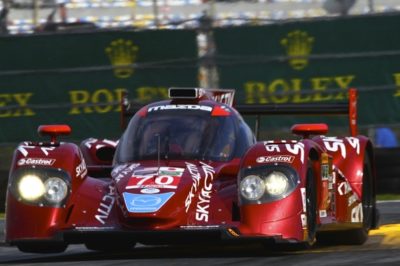As they prepare for the Rolex 24 at Daytona, Mazda and SpeedSource are making big strides with the SKYACTIV Diesel Prototypes.
The TUDOR United SportsCar Championships begins with American endurance racing’s version of The Big Game – the Rolex 24 at Daytona. While the 24-hour race is important, it doesn’t necessarily tell the story of the season, especially for the P2 cars in the Prototype category. While the P2 cars certainly have their strengths, most expect the first race of the season to go to one of the Daytona Prototypes.
Still, Mazda and the SpeedSource team come into this year’s contest in a much better position than they did last year. Taking a stock-block, 2.2-liter turbodiesel engine that did well in a Mazda6 silhouette at 450hp, putting it into a prototype and turning the wick up to nearly 600hp presented some challenges. The fact that in a year the team has dropped some six seconds off their lap time around Daytona International Speedway in the Mazda SKYACTIV Diesel Prototypes speaks volumes about that challenge and the way it was met.
“It wasn’t just the engine, it was a combination of engine and chassis improvements,” says Joel Miller, driving the No. 07 SKYACTIV Prototype with Tom Long, Ben Devlin and SpeedSource principal Sylvain Tremblay in reserve. “We learned even more at the Roar Before the 24 and we were able to improve the chassis. It was the first time we could leave the engine cover on and just focus on the improvement of the chassis.”
Much of the improvement has come from a season of racing; but perhaps even more critical is the amount of simulation the team has been using, both on the engine and the chassis side.
“The loop of design, test, race, redesign…that loop is ever shorter and ever increasing, so having simulation tools has helped turn that cycle to a much shorter time,” explains Tremblay. “We do a lot of chassis simulation, vehicle dynamic simulation, engine simulation, restrictor simulation, turbo simulation…so when we do get to where the rubber meets the road, which is track time, we are more prepared and do a better job with the resources we have. That’s been a huge foundation change for us and it really paid some big dividends in late 2014 and some of the post season.”
The team always knew the engine could produce the necessary power and, perhaps more critically, the torque. But getting that power to the ground and keeping the engine cool have been some of the bigger challenges they have faced.
“The engine is ever improving,” says Tremblay. “But I think the integration of the engine and the car is where we’ve made the biggest gains. Cooling was a big challenge for us, so we’ve really made some changes to the engine to change the cooling requirements, and so we’ve been able to close some of the ducting and openings we’ve had on the car. These prototypes are very aero sensitive, so every time you open a duct, there’s a drag cost. The drag benefit of all the changes we’ve made since Petit Le Mans are really going to show off at Daytona.”
Still, it’s likely that the banking and long straights will not be the SKYACTIV Prototype’s strong suit at Daytona. With those long stretches of wide-open throttle balanced by the tight infield section, Daytona is always a compromise. Some teams will go for more straight-line speed; others will try to make it up in the infield. “At the end of the day, which one’s better for raceability?” says Miller. “Which one is better in the last hour? Usually it’s the one that’s fastest on the banking. But there’s a method to both and the biggest thing is you want a comfortable car and I think that’s what we’re going into the race with. We know max speed is not our strong point, but we need to do lap after lap at our target lap time. To do that, we just need a consistent and comfortable car for all the drivers. That was our focus at the Roar.”
Miller says the team has been going full-bore to prepare for Daytona, both his No. 07 and the No. 70 that will be driven by Jonathan Bomarito, Tristan Nunez, IndyCar Series star James Hinchcliffe and Tremblay in reserve. If they go out, run their race and keep trouble-free, a top 10 is a definite possibility, Miller notes.
The green flag for the Rolex 24 at Daytona falls at 2:10 p.m. Eastern time on Saturday. Look for coverage on Fox Sports, imsa.com and live, in-car video with Radio Le Mans commentary on MazdaLive.com.


 ACCESSIBILITY
ACCESSIBILITY